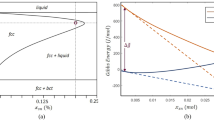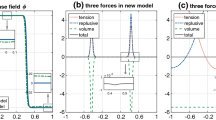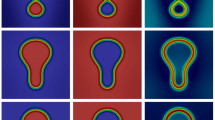Abstract
The interfacial dynamics of a system are significant in understanding the system’s behavior. One of the special models of these systems which naturally arises in material sciences is the phase separation (or spinodal decomposition) of binary alloys. A nonlinear evolution equation known as the Cahn–Hilliard equation is used to establish the mathematical modeling of a binary alloy for phase separation. Apart from trivial solutions, the Cahn–Hilliard equation is a fourth-order nonlinear equation without an analytical solution. This study investigates a second-order splitting finite difference scheme based on the 2D Crank–Nicolson technique to approximate the solution of the 2D Cahn–Hilliard problem with Neumann boundary conditions. Using the inherent error estimation of the 2D Crank–Nicolson method, we have shown that the proposed scheme is second-order accuracy and we have proved that the scheme has a unique solution. In addition, we demonstrated that the suggested technique retains mass conservation while decreasing total energy. Furthermore, we chose two numerical examples, one with a special initial value and the other with a random initial value, to confirm the accuracy of the proposed approach. These numerical experiments display physical features of the Cahn–Hilliard model such as coarsening dynamics and spinodal decomposition obtained by experimental studies of binary alloys.








Similar content being viewed by others
Data availability
Data sharing is not applicable to this article as no data sets were generated or analyzed during the current study.
References
Abazari R, Yildirim K (2019) Numerical study of Sivashinsky equation using a splitting scheme based on Crank-Nicolson method. Math Methods Appl Sci 42(16):5509–5521
Aderogba AA, Chapwanya M, Djoko JK (2014) On a fractional step-splitting scheme for the Cahn–Hilliard equation. Eng Comput 31(7):1151–1168
Agosti A, Antonietti PF, Ciarletta P, Grasselli M, Verani M (2017) A Cahn–Hilliard type equation with application to tumor growth dynamics. Math Methods Appl Sci 40(18):7598–7626
Ahmad I, Ahmad H, Inc M et al (2020) Application of local meshless method for the solution of two term time fractional-order multi-dimensional PDE arising in heat and mass transfer. Therm Sci 24(1):95–105
Akinyemi L, Iyiola OS, Akpan U (2020) Iterative methods for solving fourth-and sixth-order time-fractional Cahn–Hillard equation. Math Methods Appl Sci 43(7):4050–4074. https://doi.org/10.1002/mma.6173
Akinyemi L, Rezazadeh H, Yao SW et al (2021) Nonlinear dispersion in parabolic law medium and its optical solitons. Results Phys 26:104411. https://doi.org/10.1016/j.rinp.2021.104411
Akinyemi L, Rezazadeh H, Shi QH et al (2021) New optical solitons of perturbed nonlinear Schrödinger–Hirota equation with spatio-temporal dispersion. Results Phys 29:104656. https://doi.org/10.1016/j.rinp.2021.104656
Ashpazzadeh E, Chu YM, Hashemi MS, Moharrami M, Inc M (2022) Hermite multiwavelets representation for the sparse solution of nonlinear Abel integral equation. Appl Math Comput 427:127171. https://doi.org/10.1016/j.amc.2022.127171
Bai F, Elliott CM, Gardiner A, Spence A, Stuart AM (1995) The viscous Cahn–Hilliard equation: I. Computations. Nonlinearity 8(2):131–160
Barrett BG, Blowey JF, Garcke H (1999) Finite element approximation of the Cahn–Hilliard equation with degenerate mobility. SIAM J Numer Anal 37(1):286–318
Benkert K, Fischer R (2007) An efficient implementation of the thomas-algorithm for block penta-diagonal systems on vector computers. Comput Sci ICCS 2007. ICCS
Cahn JW, Hilliard JE (1958) Free energy of a non-uniform system. I. Interfacial free energy. J Chem Phys 28:258–267
Chang X, Zhang L, Ma R et al (2019) Numerical investigation on aerodynamic performance of a bionic flapping wing. Appl Math Mech Engl Ed 40:1625–1646
Cheng Y, Kurganov A, Qu Z, Tang T (2015) Fast and stable explicit operator splitting methods for phase-field models. J Comput Phys 303:45–65
Daher A, Ammar A, Hijazi A (2019) Nanoparticles migration near liquid-liquid interfaces using diffuse interface model. Eng Comput 36(3):1036–1054
Elliott CM, French DA, Milner FA (1989) A second order splitting method for the Cahn–Hilliard equation. Numer Math 54(5):575–590
Gidey HH, Reddy BD (2019) Operator-splitting methods for the 2D convective Cahn–Hilliard equation. Comput Math Appl 77:3128–3153
Grasselli M, Pierre M (2010) A splitting method for the Cahn–Hilliard equation with inertial term. Math Models Methods Appl Sci 20(8):1–28
Guo R, Xu Y (2014) Efficient solvers of discontinuous Galerkin discretization for the Cahn–Hilliard equations. J Sci Comput 58(2):380–408
Gurtin ME (1996) Generalized Ginzburg–Landau and Cahn–Hilliard equations based on a microforce balance. Phys D 92(3–4):178–192
Hashemi MS (2021) Numerical study of the one-dimensional coupled nonlinear sine-Gordon equations by a novel geometric meshless method. Eng Comput 37:3397–3407
Hashemi MS, Ashpazzadeh E, Moharrami M, Lakestani M (2021) Fractional order Alpert multiwavelets for discretizing delay fractional differential equation of pantograph type. Appl Numer Math 170:1–13
He L, Yunxian L (2009) A class of stable spectral methods for the Cahn–Hilliard equation. J Comput Phys 228:5101–5110
Khiari N, AchouriT Mohamed M. L, Ben Omrani K (2007) Finite difference approximate solutions for the Cahn–Hilliard equation. Numer Methods Partial Differ Equ 23(2):437–455
Kulikov AN, Kulikov DA (2021) Cahn–Hilliard equation with two spatial variables. Pattern formation. Theor Math Phys 207(3):782–798
Lee H, Jeong D, Shin J, Li Y, Kim J (2014) A fourth-order spatial accurate and practically stable compact scheme for the Cahn–Hilliard equation. Phys A 409:17–28
Lee C, Jeong D, Yang J, Kim J (2020) Nonlinear multigrid implementation for the two-dimensional Cahn–Hilliard equation. Mathematics 8(1):97. https://doi.org/10.3390/math8010097
Li Y, Lee C, Wang J, Yoon S, Park J, Kim J (2021) A simple benchmark problem for the numerical methods of the Cahn–Hilliard equation. Discrete Dyn Nat Soc 2021:8889603. https://doi.org/10.1155/2021/8889603
Shahrbabaki A. Shabani, Abazari R (2009) Perturbation method for heat exchange between a gas and solid particles. J Appl Mech Tech Phys 50(6):959–964
van der Waals JD (1893) The thermodynamic theory of capillarity flow under the hypothesis of a continuous variation of density. Verhandel Konink Akad Weten Amsterdam, 1
Wells GN, Kuhl E, Garikipati KA (2006) A discontinuous Galerkin method for the Cahn–Hilliard equation. J Comput Phys 218(2):860–877
Zou Q (2021) An image inpainting model based on the mixture of Perona–Malik equation and Cahn–Hilliard equation. J Appl Math Comput 66:21–38
Author information
Authors and Affiliations
Corresponding author
Ethics declarations
Conflict of interest
The authors declare that they have no conflict of interest.
Additional information
Communicated by Baisheng Yan.
Publisher's Note
Springer Nature remains neutral with regard to jurisdictional claims in published maps and institutional affiliations.
Rights and permissions
Springer Nature or its licensor (e.g. a society or other partner) holds exclusive rights to this article under a publishing agreement with the author(s) or other rightsholder(s); author self-archiving of the accepted manuscript version of this article is solely governed by the terms of such publishing agreement and applicable law.
About this article
Cite this article
Abazari, R., Rezazadeh, H., Akinyemi, L. et al. Numerical simulation of a binary alloy of 2D Cahn–Hilliard model for phase separation. Comp. Appl. Math. 41, 389 (2022). https://doi.org/10.1007/s40314-022-02109-5
Received:
Revised:
Accepted:
Published:
DOI: https://doi.org/10.1007/s40314-022-02109-5
Keywords
- Interface problems
- Phase separation
- Cahn–Hilliard equation
- Splitting scheme
- Crank–Nicolson method
- Solvability




